 Growing inequality of income and wealth is a common pattern throughout the world. In the boom years up to 2008, the rich got a lot richer, but at least those on low incomes generally saw modest rises in their incomes. Since 2008, however, the continually widening gap between rich and poor has seen the poor and many on middle incomes getting absolutely poorer.
Growing inequality of income and wealth is a common pattern throughout the world. In the boom years up to 2008, the rich got a lot richer, but at least those on low incomes generally saw modest rises in their incomes. Since 2008, however, the continually widening gap between rich and poor has seen the poor and many on middle incomes getting absolutely poorer.
The problem is particularly acute in the USA. Indeed, in his 2012 State of the Union address, President Obama said that it was the ‘defining issue of our time.’
No challenge is more urgent. No debate is more important. We can either settle for a country where a shrinking number of people do really well, while a growing number of Americans barely get by. Or we can restore an economy where everyone gets a fair shot, everyone does their fair share, and everyone plays by the same set of rules.
The good news for the poor in the USA is that at last their incomes have stopped falling, thanks to stronger economic growth. But their share of the growth in GDP is tiny. As The Economist article states:
As The Economist article states:
The main message is a grim one. Most of the growth is going to an extraordinarily small share of the population: 95% of the gains from the recovery have gone to the richest 1% of people, whose share of overall income is once again close to its highest level in a century. The most unequal country in the rich world is thus becoming even more so.
Apart from the ethical question of whether it is desirable for a society, already highly unequal, to become even more so, there is the question of whether this growth in inequality threatens economic recovery. Joseph Stiglitz argues that the rich have a low marginal propensity to consume and that this is threatening recovery.
Then there is the question of investment. Because most Americans have not seen any significant rise in incomes, it is easy for them to believe that the country cannot afford to invest more. And certainly it is difficult to persuade people that higher taxes are warranted to fund education, infrastructure or research.
The following articles consider the problem and its implications and look at various policy alternatives.
Articles and videos
Inequality: Growing apart The Economist (21/9/13)
What is income inequality, anyway? CNN, John D. Sutter (29/10/13)
Inequality is literally killing America Press TV (22/11/13)
It’s Economic Inequality Stupid – What to Do About the Biggest Crisis Facing America Huffington Post, Robert Creamer (14/11/13)
US Inequality Now Literally Off the Chart Truthout, Salvatore Babones (8/6/13)
Inequality moves to the front line of US politics Financial Times, Richard McGregor (20/11/13)
 Is wealth inequality slowing growth? BBC News, Linda Yueh (21/11/13)
Is wealth inequality slowing growth? BBC News, Linda Yueh (21/11/13)
American Inequality in Six Charts The New Yorker, John Cassidy (18/11/13)
 Income Inequality ‘Profoundly Corrosive’ Wall Street Journal, Larry Summers (19/11/13)
Income Inequality ‘Profoundly Corrosive’ Wall Street Journal, Larry Summers (19/11/13)
21 Charts On US Inequality That Everyone Should See Business Insider, Gus Lubin (12/11/13)
Data, information and reports
Income inequality in the United States Wikipedia
Inequality Data & Statistics Inequality.org
Income Main United States Census Bureau
World of Work Report 2013: Snapshot of the United States ILO
World of Work Report 2013 ILO
StatExtracts OECD (Search for Gini)
Questions
- How may income inequality be measured?
- Comment on the Gini coefficients in the above link to the StatExtracts site.
- Why has inequality grown in the USA?
- The Swiss have just voted in a referendum to reject a proposal to limit executive pay to 12 times that of the lowest paid worker in the same company. What are the arguments for and against the proposal?
- What features of an unequal society tend to perpetuate or even deepen that inequality over time?
- What features of a well functioning market economy would help to reduce income inequality?
- Are higher marginal tax rates and higher welfare payments the best way of reducing inequality? What other policy options are there?
- Compare the views of Paul Krugman and Joseph Stiglitz on the effects of growing inequality on economic growth. How significant is the difference in the marginal propensity to consume of the rich and the poor in explaining the relatively low rate of US economic growth?
 The enormous amounts of money broadcasters are willing to pay for the rights to show live football astonish most people. The figures have continued to rise despite the impact of a recession, slow economic growth and static or falling real incomes.
The enormous amounts of money broadcasters are willing to pay for the rights to show live football astonish most people. The figures have continued to rise despite the impact of a recession, slow economic growth and static or falling real incomes.
The deal to broadcast live games in the English Premier League (EPL) for the three seasons from 2007-10 was 65% higher than the agreement that ran from 2004-07. The recession did appear to slow growth down as the contract covering the seasons 2010-13 was only 5% higher than the previous one. However the total size of this deal was still a staggering £1.78billion or approximately £593 million per season. BSkyB was the most successful bidder in all of these auctions for live TV rights and successfully saw off competition from ITV Digital, ESPN and Setanta.
However in the last few years, BT Sport has entered the bidding process and has provided BSkyB with much stronger competition than its previous rivals. As a result, BskyB had to pay £2.3 billion in order to outbid BT Sport in the most recent auction.  The three-year deal beginning in the 2013-14 season gives BSkyB the rights to show 116 lives matches each year. BT Sport also paid £738 million for the rights to show 38 live matches a season. In total this means that the EPL earns approximately £1billion per season from the sale of broadcasting rights in the domestic market – an increase of 70%!
The three-year deal beginning in the 2013-14 season gives BSkyB the rights to show 116 lives matches each year. BT Sport also paid £738 million for the rights to show 38 live matches a season. In total this means that the EPL earns approximately £1billion per season from the sale of broadcasting rights in the domestic market – an increase of 70%!
The Champions and Europa League also auction the rights to broadcast live matches and there was a real shock when BT Sport recently announced that it had secured the exclusive rights to show all 350 live games in these competitions. Once again the figure it paid – just under £900 million for a three-year deal – took most people by surprise. It represented a 125% increase on the previous three-year deal with BSkyB and ITV. What was also surprising was that there was only one round in the sealed bid auction which suggests that BT Sport’s offer was well in excess of the one submitted by BSkyB.
Most of the initial reaction to this new deal has focused on its implications for the number of matches that will be available free to air: i.e. without having to pay for a subscription channel. The BT Sport contract does specify that the Champions League final and at least one match involving each British team will be shown free to air each season. However, this will be a significant reduction in the number of free to air games currently shown by ITV.
The new deal may also have implications for competitive balance in the EPL. This concept was discussed in a previous blog on this New Site Parachute payment problems for the English Football League and refers to how equally the most talented players are distributed amongst the teams in a league. This distribution will be heavily influenced by the degree to which the revenues of the teams in the league vary. Commenting on this latest contract Liverpool’s former managing director Christian Purslow stated that:
The fundamental effect of the BT deal will be additional wealth for England’s big teams. You will now have six teams (Manchester City, Chelsea and Manchester United, Arsenal, Liverpool and Spurs) playing for four Champions league places with the other 14 teams playing for survival. Never again will the likes of Everton, Newcastle or Villa get near the top – the difference in revenues will simply be too great.
To understand this statement one has to examine how the Champions League distributes the revenue it raises back to the teams that participate in the tournament. One part of the distribution mechanism is determined by the sporting performance of the teams in the competition.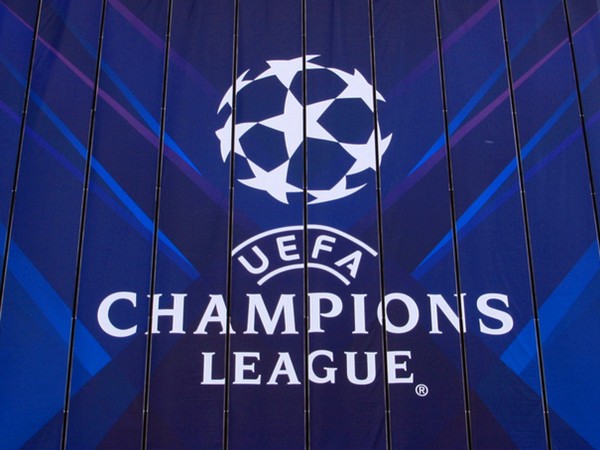 For example all 32 teams that make it to the group stages of the Champions League receive a minimum of €8.6 million. Each win in the group games earns a team an additional €1 million while a draw earns €500,000. The teams that make it to the last 16 receive an additional payment of €3.5 million, the quarter finalists earn an additional €3.9 million while the semi-finalists each receive €4.9 million. For example in the 2012-13 season, Manchester United received prize money of €16.1 million for reaching the last 16, whereas Bayern Munich received €35.9 million of prize money for winning the competition. If broadcasting revenues for the Champions League increase across the whole of Europe then the size of the prizes will almost certainly increase.
For example all 32 teams that make it to the group stages of the Champions League receive a minimum of €8.6 million. Each win in the group games earns a team an additional €1 million while a draw earns €500,000. The teams that make it to the last 16 receive an additional payment of €3.5 million, the quarter finalists earn an additional €3.9 million while the semi-finalists each receive €4.9 million. For example in the 2012-13 season, Manchester United received prize money of €16.1 million for reaching the last 16, whereas Bayern Munich received €35.9 million of prize money for winning the competition. If broadcasting revenues for the Champions League increase across the whole of Europe then the size of the prizes will almost certainly increase.
Teams also receive a share of the broadcasting revenue generated by the Champions League known as the market pool. The total size of the market pool allocated to the teams in any particular country depends on the value of the deal between the broadcasters in that country and UEFA. In the 2012-13 season the total market pool to be divided between the four English teams in the Champions League was €86.6 million. This was the second highest figure behind Italy. In contrast the four Portuguese teams had just over €7 million from the market pool to share between them because the value of the broadcasting deal in that country was so much lower. The market pool is split between the clubs based on (a) their finishing position in the domestic league the previous season and (b) how many games they played in the Champions League from the group stage onwards. FC BATE Borisov were the only representative from Belarus so did not have to share the market pool with any other team. Unfortunately for them the size of the market pool was only €290,000. Manchester United received a market pool payment of €19.45 million.
Given the dramatic increase in value of the broadcasting rights the size of the market pool for the English teams will rise significantly in 2015-16 season. The battle in the 2014-15 EPL season for the four Champions League places will be even stronger and more intense than ever. As a result, the competition for the services of the most talented players will probably push up their wages to ever higher levels.
Monopoly money: Football’s TV war makes the rich unreachable’ BBC Sport (17/11/13)
Champions League TV deal in focus BBC Business (11/11/13)
Champions League: BT Sport wins £897 football rights deal BBC Sport (9/11/13)
Top Soccer Leagues Get 25% Rise in TV Rights Sales, Report Says Bloomberg (11/11/13)
BSkyB could face Premier League premium The Guardian (11/11/13)
Clubs benefit from Champions League revenue UEFA (23/7/13)
Sky pleaded with football officials to reopen champions league talks The Telegraph (11/11/13).
Questions
- What is a sealed bid auction? How does it compare with different types of auctions?
- Suggest some reasons why BT Sport were willing to pay so much more than BSkyB for the broadcasting rights for the Champions League.
- Do you think that the potentially higher revenues for the top clubs might actually reduce attendances at their matches? Explain your answer.
- Explain how the potentially higher future revenues for teams participating in the Champions League in 2015-16 can be discounted in order to give them a present value.
- Draw a diagram to illustrate the impact of the new broadcasting deal on the marginal revenue product of the most talented players.
- Is the labour market for the most talented players competitive or is it an oligopsony? What implications does this have their wages? How does your answer change if the labour market is a bilateral monopoly?
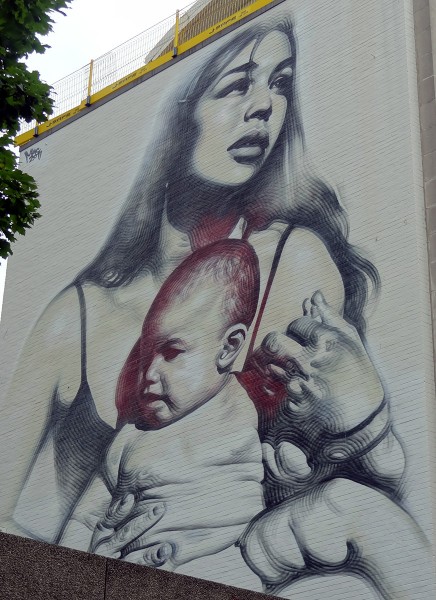 Each year in November, the Living Wage Foundation publishes figures for the hourly living wage that is necessary for people to meet basic bills. The rate for London is calculated by the Greater London Authority and for the rest of the UK by the Centre for Research in Social Policy at Loughborough University.
Each year in November, the Living Wage Foundation publishes figures for the hourly living wage that is necessary for people to meet basic bills. The rate for London is calculated by the Greater London Authority and for the rest of the UK by the Centre for Research in Social Policy at Loughborough University.
The 2013 update was published on 4 November. The Living Wage was estimated to be £8.80 in London and £7.65 in the rest of the UK.
Two things need to be noted about the Living Wage rate. The first is that the figure is an average and thus does not take into account the circumstances of an individual household. Clearly households differ in terms of their size, the number of wage earners and dependants, the local costs of living, etc. Second, the figures have been reduced from what is regarded as the ‘reference’ living wage, which is estimated to be £9.08 outside London. The reason for this is that people earning higher incomes have seen their living standards squeezed since 2009, with prices rising faster than average post-tax-and-benefit wages. Thus, the Living Wage is capped to reflect the overall decline in living standards. As the Working Paper on rates outside London explains:
From 2012 onwards, two kinds of limit have been put on the amount that the Living Wage as applied can rise in any one year. The first limits the increase in the net income (after taxes and benefits) requirement for each household on which the living wage calculation is based, relative to the rise in net income that would be achieved by someone on average earnings. The second limits the increase in the living wage itself (representing gross income) relative to the increase in average earnings.
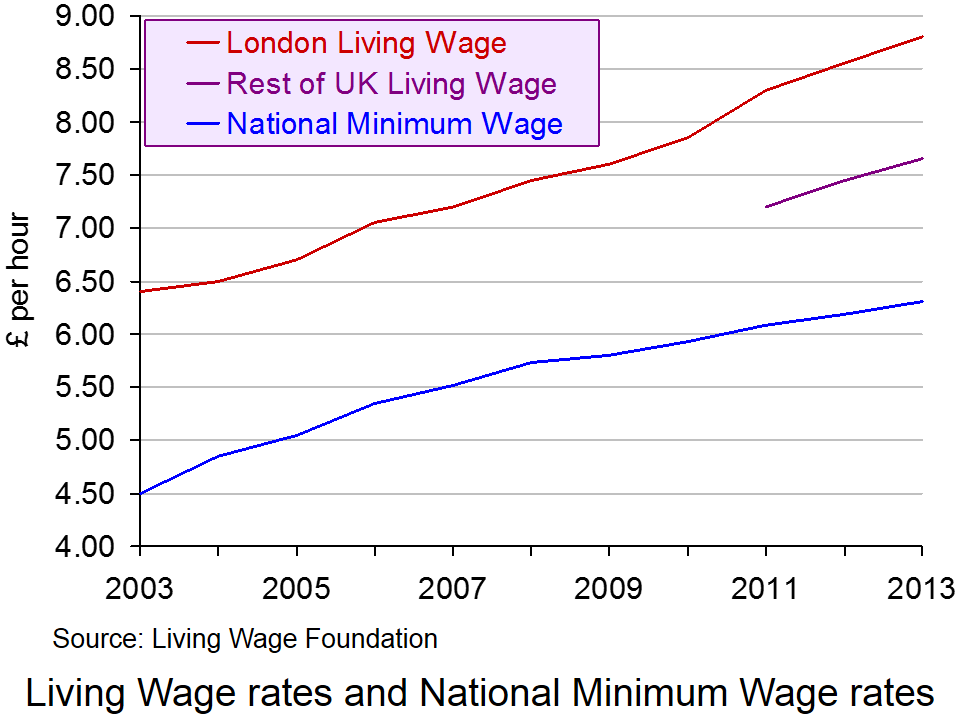 Nevertheless, despite this capping of the living wage, it is still significantly higher than the UK National Minimum Wage, which currently stands at £6.31 for those aged 21 and over. This can be seen from the chart (click here for a PowerPoint).
Nevertheless, despite this capping of the living wage, it is still significantly higher than the UK National Minimum Wage, which currently stands at £6.31 for those aged 21 and over. This can be seen from the chart (click here for a PowerPoint).
Paying the Living Wage is voluntary for employers, but as The Guardian reports:
A total of 432 employers are now signed up to the campaign, up from 78 this time last year, including Legal & General, KPMG, Barclays, Oxfam, Pearson, the National Portrait Gallery and First Transpennine Express, as well as many smaller businesses, charities and town halls. Together they employ more than 250,000 workers and also commit to roll out the living wage in their supply chain.
But as The Observer reports:
The number of people who are paid less than a ‘living wage’ has leapt by more than 400,000 in a year to over 5.2 million, amid mounting evidence that the economic recovery is failing to help millions of working families.
A report for the international tax and auditing firm KPMG also shows that nearly three-quarters of 18-to-21-year-olds now earn below this level – a voluntary rate of pay regarded as the minimum to meet the cost of living in the UK. The KPMG findings highlight difficulties for ministers as they try to beat back Labour’s claims of a “cost of living crisis”.
According to the report, women are disproportionately stuck on pay below the living wage rate, currently £8.55 in London and £7.45 elsewhere. Some 27% of women are not paid the living wage, compared with 16% of men. Part-time workers are also far more likely to receive low pay than full-time workers, with 43% paid below living-wage rates compared with 12% of full-timers.
But although paying a living wage may be desirable in terms of equity, many firms, especially in the leisure and retailing sectors, claim that they simply cannot afford to pay the living wage and, if they were forced to, would have to lay off workers.
The point they are making is that it is not economical to pay workers more than their marginal revenue product. But this raises the question of whether a higher wage would encourage people to work more efficiently. If it did, an efficiency wage may be above current rates for many firms. It also raises the question of whether productivity gains could be negotiated in exchange for paying workers a living wage
These arguments are discussed in the following podcast.
Podcast
 Higher ‘productivity’ will increase living wage BBC Today Programme, Priya Kothari and Steve Davies (4/11/13)
Higher ‘productivity’ will increase living wage BBC Today Programme, Priya Kothari and Steve Davies (4/11/13)
Articles
UK living wage rises to £7.65 an hour The Guardian (4/11/13)
More than 5 million people in the UK are paid less than the living wage The Observer, Toby Helm (2/11/13)
Increasing numbers of Scots are paid less than living wage Herald Scotland (2/11/13)
Labour would give tax rebates to firms that pay living wage Independent, Jane Merrick (3/11/13)
Employers praise Ed Miliband’s living wage proposal Independent, Andy McSmith (3/11/13)
Miliband’s living wage tax break will raise prices, warns CBI chief The Telegraph, Tim Ross (3/11/13)
Living Wage rise provides a boost for low paid workers BBC News (4/11/13)
Information and Reports
What is the Living Wage? Living Wage Foundation
The Living Wage Centre for Research in Social Policy, Loughborough University
Living wage Mayor of London
One in five UK workers paid less than the Living Wage KPMG News Release (3/11/13)
Number of workers paid less than the Living Wage passes 5 million KPMG News Release (3/11/13)
Living Wage Research for KPMG Markit (October 2012)
Questions
- How is the Living Wage calculated?
- What are the reasons for announcing a Living Wage figure that is lower than a reference living wage? Assess these reasons.
- If there are two separate figures for the Living Wage for London and the rest of the UK, would it be better to work out a living wage for each part, or even location, of the UK?
- Why might it be in employers’ interests to pay at least the Living Wage? Does this explain why more and more employers are volunteering to pay it?
- Assess the Labour Party’s pledge, if they win the next election, that ‘firms which sign up to the living wage will receive a tax rebate of up to £1000 for every low-paid worker who gets a pay rise, funded by tax and national insurance revenue from the higher wages’.
- Which is fairer: to pay everyone at least the Living Wage or to use tax credits to redistribute incomes to low-income households?
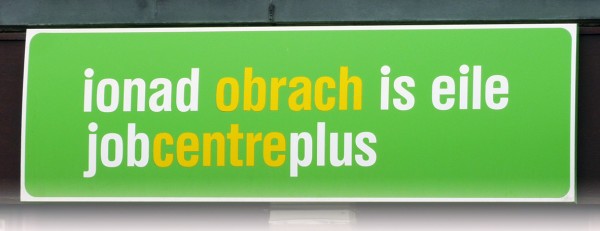 First the good news. Employment is rising and unemployment is falling. Both claimant count rates and Labour Force Survey rates are down. Compared with a year ago, employment is up 279,092 to 29,869,489; LFS unemployment is down from 7.87% to 7.69%; and the claimant count rate is down from 4.7% to 4.0%.
First the good news. Employment is rising and unemployment is falling. Both claimant count rates and Labour Force Survey rates are down. Compared with a year ago, employment is up 279,092 to 29,869,489; LFS unemployment is down from 7.87% to 7.69%; and the claimant count rate is down from 4.7% to 4.0%.
Now the bad news. Even though more people are in employment, real wages have fallen. In other words, nominal wages have risen less fast than prices. Since 2009, real wages have fallen by 7.6% and have continued to fall throughout this period. The first chart illustrates this. It shows average weekly wage rates in 2005 prices. (Click here for a PowerPoint of the chart.)
have continued to fall throughout this period. The first chart illustrates this. It shows average weekly wage rates in 2005 prices. (Click here for a PowerPoint of the chart.)
The fall in real wages is an average for the whole country. Many people, especially those on low incomes, have seen their real wages fall much faster than the average. For many there is a real ‘cost of living’ crisis.
But why have real wages fallen despite the rise in employment? The answer is that output per hour worked has declined. This is illustrated in the second chart, which compares UK output per worker with that of other G7 countries. UK productivity has fallen both absolutely and relative to other G7 countries, most of which have had higher rates of investment.
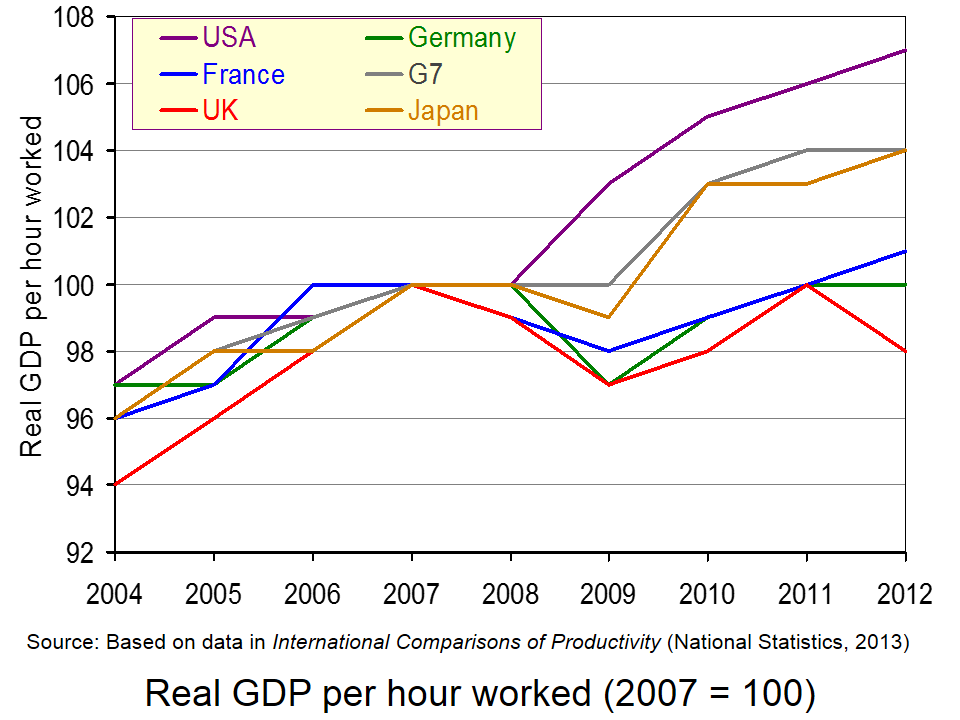 The falling productivity in the UK requires more people to be employed to produce the same level of output. Part of what seems to be happening is that many employers have been prepared to keep workers on in return for lower real wages, even if demand from their customers is falling. And many workers have been prepared to accept real wage cuts in return for keeping their jobs.
The falling productivity in the UK requires more people to be employed to produce the same level of output. Part of what seems to be happening is that many employers have been prepared to keep workers on in return for lower real wages, even if demand from their customers is falling. And many workers have been prepared to accept real wage cuts in return for keeping their jobs.
Another part of the explanation is that the jobs that have been created have been largely in low-skilled, low-wage sectors of the economy, such as retailing and other parts of the service sector.
But falling productivity is only part of the reason for falling real wages. The other part is rising prices. A number of factors have contributed to this. These include a depreciation of the exchange rate back in 2008, the effects of which took some time to filter through into higher prices in the shops; a large rise in various commodity prices; and a rise in VAT and various other administered prices.
So what is the answer to falling real wages? The articles below consider the problem and some of the possible policy alternatives.
Articles
Inflation, unemployment and UK ‘misery’ BBC News, Linda Yueh (16/10/13)
Employment is growing, but so are the wage slaves The Guardian, Larry Elliott (16/10/13)
Living standards – going down and, er, up BBC News, Nick Robinson (26/7/13)
Revealed: The cost of living is rising faster in the UK than anywhere in Europe, with soaring food and energy bills blamed Mail Online, Matt Chorley (16/10/13)
Cutting prices to raise living standards is just a waste of energy The Telegraph, Roger Bootle (6/10/13)
Downturn sees average real wages collapse to a record low Independent, Ben Chu (17/10/13)
Why living standards and public finances matter Financial Times, Gavin Kelly (29/9/13)
Social Mobility Tsar Alan Milburn Calls on Government to Boost Wages to End UK Child Poverty International Business Times, Ian Silvera (17/10/13)
Do incorrect employment growth figures explain low UK productivity? The Guardian, Katie Allen (23/10/13)
Data
Unemployment data ONS
Average Weekly Earnings dataset ONS
Consumer Prices Index ONS
International Comparison of Productivity ONS
Questions
- How are real wages measured?
- Why have real wage rates fallen in the UK since 2009?
- What factors should be included when measuring living standards?
- Why has employment risen and unemployment fallen over the past two years?
- What factors could lead to a rise in real wages in the future?
- What government policies could be adopted to raise real wages?
- Assess these policies in terms of their likely short-term success and long-term sustainability.
 At a cost of €1 trillion to EU states, tax evasion is undoubtedly an area in need of attention. With government finances in deficit across the world, part of the gap could be plugged by preventing tax revenues from going unpaid. Well-known companies and individuals have been accused of tax evasion (and avoidance), but part of the problem is the existence of countries that make such activities possible.
At a cost of €1 trillion to EU states, tax evasion is undoubtedly an area in need of attention. With government finances in deficit across the world, part of the gap could be plugged by preventing tax revenues from going unpaid. Well-known companies and individuals have been accused of tax evasion (and avoidance), but part of the problem is the existence of countries that make such activities possible.
Tax havens not only offer favourable tax rates, but also have in place regulations that prevent the effective exchange of information. That is, they are able to keep the identity and income information of depositors a private affair and are not required to share that information with other governments. This means that other tax authorities are unable to demand the tax revenue from income earned, when it is held in some of these countries. This can deprive the government’s coffers of substantial amounts of money.
In 2000, the OECD produced a report naming so-called ‘uncooperative tax havens’, including Monaco, Andorra, Liechtenstein and Liberia. Since then, all nations on this list have pledged their cooperation and been removed and in a recent step, Andorra has announced a proposal to implement its first ever income tax. This move is partly in response to pressures from EU governments to tackle tax evasion. Furthermore, talks between the finance ministers of tax havens, such as Switzerland and Liechtenstein have been agreed with the aim of improving the flow of bank account information and thus combating tax evasion. The Council of the European Union said:
The decision represents an important step in the EU’s efforts to clamp down on tax evasion and tax fraud”
Countries, such as Switzerland (a non-EU member) are likely to find requests for information difficult to ignore, if they want to have access to EU financial markets. However, any concessions on information provision will come at a significant cost for a country that has long regarded its banking secrecy as an ‘honourable policy.
 Reforming policy on tax havens is essential, not only to help tackle tax evasion and thus government deficits, but also to generate investment into countries that don’t offer such favourable tax rates. Investors naturally want to invest in those countries with low tax rates and as such, could it be that countries like the UK suffer from a loss of investment and that the only way to encourage it is to offer similarly low tax rates? International agreement is certainly needed to tackle the worldwide issue of tax evasion and at the moment, it seems as though pressure is building on secretive countries. The following articles consider this controversial issue.
Reforming policy on tax havens is essential, not only to help tackle tax evasion and thus government deficits, but also to generate investment into countries that don’t offer such favourable tax rates. Investors naturally want to invest in those countries with low tax rates and as such, could it be that countries like the UK suffer from a loss of investment and that the only way to encourage it is to offer similarly low tax rates? International agreement is certainly needed to tackle the worldwide issue of tax evasion and at the moment, it seems as though pressure is building on secretive countries. The following articles consider this controversial issue.
Clock ticks on Swiss banking secrecy BBC News, Imogen Foulkes (21/5/13)
Andorra bows to EU pressure to introduce income tax The Telegraph, Fiona Govan (2/6/13)
Andorra to introduce income tax for first time BBC News (2/6/13)
Andorra to introduce income tax for the first time Economy Watch (3/6/13)
Swiss have no choice but to bow to US ultimatum – Ackermann Reuters, Katharina Bart> (3/6/13)
Austria out front as EU zeroes in on tax evasion The Budapest Times (29/5/13)
EU to start talks with non-EU countries on tax evasion BBC News (14/5/13)
Questions
- What is tax evasion?
- Using game theory, explain why an international agreement on tax evasion might be needed?
- When an income tax is imposed in Andorra, what will be the impact on government revenues?
- How might the labour supply incentive change once an income tax is imposed?
- How do tax havens affect investment in other countries?
- Is there an argument that countries such as the UK should cut its tax rates to encourage investment?
 Growing inequality of income and wealth is a common pattern throughout the world. In the boom years up to 2008, the rich got a lot richer, but at least those on low incomes generally saw modest rises in their incomes. Since 2008, however, the continually widening gap between rich and poor has seen the poor and many on middle incomes getting absolutely poorer.
Growing inequality of income and wealth is a common pattern throughout the world. In the boom years up to 2008, the rich got a lot richer, but at least those on low incomes generally saw modest rises in their incomes. Since 2008, however, the continually widening gap between rich and poor has seen the poor and many on middle incomes getting absolutely poorer. As The Economist article states:
As The Economist article states: Is wealth inequality slowing growth? BBC News, Linda Yueh (21/11/13)
Is wealth inequality slowing growth? BBC News, Linda Yueh (21/11/13) Income Inequality ‘Profoundly Corrosive’ Wall Street Journal, Larry Summers (19/11/13)
Income Inequality ‘Profoundly Corrosive’ Wall Street Journal, Larry Summers (19/11/13)








